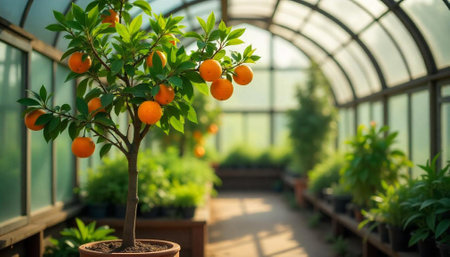Introduction to Year-Round Fruit Growing in UK Greenhouses
The unpredictable British weather is notorious for its chilly springs, brief summers, and damp autumns, presenting a unique set of challenges to those keen on growing fruit crops. Traditionally, the natural growing season in the UK is short, often limiting growers to a single harvest and a narrow selection of fruits. However, the use of greenhouses has transformed this landscape, making it possible to cultivate a wide variety of fruit crops throughout the year. Seasonality remains an important consideration: consumers increasingly seek fresh, locally grown produce regardless of the month, while growers must navigate fluctuations in daylight hours, temperature extremes, and humidity. Controlled environments within greenhouses offer significant advantages—they buffer crops against frost, heavy rain, pests, and sudden temperature drops. By regulating conditions such as light intensity, warmth, and ventilation, British greenhouse growers can extend growing seasons, boost yields, and diversify their crop selection. This ability to sidestep the limitations of traditional outdoor cultivation not only supports local food security but also reduces reliance on imported fruit. As we explore how to maximise greenhouse yields across every season in the UK, understanding both the challenges and opportunities offered by our unique climate is essential.
Choosing the Right Fruit Crops for Each Season
One of the most rewarding aspects of greenhouse growing in the UK is the ability to extend the fruiting season, making it possible to enjoy a diverse harvest throughout the year. However, choosing crops that are both suited to our climate and responsive to seasonal changes is crucial for maximising yields and ensuring consistent success. Below, we summarise popular and practical fruit crops for each season, factoring in their suitability for British greenhouses and relevant cultural considerations.
Spring Selections
As daylight increases and temperatures begin to rise, spring is a prime time for early starters. Strawberries are a classic choice, especially everbearing varieties like ‘Albion’ which adapt well to protected environments. Early dwarf peaches and nectarines can also be introduced with careful attention to ventilation and humidity control.
Summer Staples
The summer months open up a wider selection of fruit crops that benefit from sustained warmth. Tomatoes (often debated as fruit or veg), cucumbers, melons such as ‘Honeydew’, and figs thrive in these conditions. Grape vines are another favourite, offering both eating and wine-making potential—varieties like ‘Phoenix’ and ‘Seyval Blanc’ are well-suited to greenhouse culture in Britain’s variable weather.
Autumn Options
As temperatures cool, some fruits continue producing or reach peak ripeness. Late-season strawberries, autumn-fruiting raspberries (‘Polka’ or ‘Joan J’), and cape gooseberries (physalis) can all provide a sweet finale to the main growing season. These crops benefit from residual warmth retained by greenhouse structures.
Winter Winners
While winter presents obvious challenges, certain crops still perform admirably under glass. Citrus trees—particularly lemons and calamondin oranges—can be overwintered indoors, provided they receive adequate light and occasional warmth. Alpine strawberries and potted blueberries may also set fruit if conditions are managed carefully.
Seasonal Suitability Table
| Crop | Best Season(s) | Cultural Notes |
|---|---|---|
| Strawberries | Spring/Autumn | Everbearing types excel; use fleece for early/late protection |
| Dwarf Peaches/Nectarines | Spring/Summer | Monitor humidity to prevent leaf curl |
| Tomatoes | Summer | Consistent feeding; ventilate to avoid blight |
| Grapes (‘Phoenix’, ‘Seyval Blanc’) | Summer/Autumn | Prune regularly for airflow; watch for mildew |
| Citrus (Lemon, Calamondin) | Winter (indoors) | Supplemental lighting often required; avoid overwatering |
| Cape Gooseberry (Physalis) | Autumn | Tolerant of cooler nights; stake plants as needed |
| Blueberries (in pots) | Late Winter/Early Spring (forced) | Use ericaceous compost; pollinate by hand if necessary |
Cultural Considerations for UK Growers
The unpredictable nature of British weather places emphasis on flexibility. Many growers opt for varieties bred specifically for shorter seasons or low light conditions. Additionally, integrating traditional UK practices such as companion planting or organic mulching helps maintain soil health and reduce pest pressure without reliance on chemicals. By matching your crop choices to both seasonal opportunities and local cultural wisdom, you’ll put yourself in the best position for year-round fruitfulness.

3. Optimising Greenhouse Conditions for Maximum Yields
One of the defining challenges of fruit crop production in the UK is adapting to unpredictable weather patterns and variable seasonal conditions. Maximising greenhouse yields requires a keen understanding of the local climate and the application of key techniques and technologies to control temperature, light, ventilation, and humidity. Below, we’ll explore practical strategies used by experienced UK growers to maintain optimal environments throughout the year.
Temperature Management
British weather can shift rapidly, so precise temperature regulation is crucial. Modern greenhouses often employ automated heating systems for colder months and shading or evaporative cooling methods during heatwaves. Thermostatic controls linked to sensors are invaluable for keeping temperatures within ideal ranges for specific fruit crops like tomatoes or strawberries. Many growers also use thermal screens at night to retain heat and reduce energy costs, a significant consideration given rising utility prices in the UK.
Lighting Solutions
The lack of consistent sunlight—especially during short winter days—makes supplemental lighting a must for year-round fruiting. LED grow lights are popular due to their energy efficiency and ability to provide tailored light spectra suited to different crop stages. Timed lighting regimes help extend photoperiods, encouraging steady growth and higher yields even when natural light is scarce.
Ventilation Strategies
Good airflow prevents fungal diseases and supports robust plant development. In the UK’s damp climate, automated roof vents, side vents, and louvres are commonly used to regulate air exchange without losing too much heat. Some advanced setups integrate CO₂ enrichment alongside ventilation controls to further boost productivity. For smaller operations, manual venting combined with oscillating fans can still make a notable difference.
Humidity Control
Given the naturally high humidity in many parts of Britain, especially in spring and autumn, maintaining optimal moisture levels is key to preventing mildew and rot. Dehumidifiers or desiccant systems are increasingly common in commercial greenhouses, while home growers might rely on careful watering practices and increased airflow. Monitoring equipment that tracks relative humidity allows for swift adjustments as weather shifts unexpectedly.
Tailoring Approaches for British Conditions
The UK’s unique blend of mild winters, cool summers, and frequent rainfall means there is no one-size-fits-all approach. Success hinges on regularly monitoring environmental variables and being prepared to tweak systems at short notice—a true blend of science, engineering, and local know-how. By leveraging modern technology alongside traditional gardening wisdom, growers across Britain are now able to enjoy bountiful harvests from their greenhouses regardless of season.
4. Sustainable Growing Practices
Ensuring sustainability within British greenhouses is essential for both crop health and environmental stewardship. By adopting eco-friendly fertilisation, integrated pest management (IPM), and water conservation strategies, growers can achieve consistent yields of fruit crops year-round while minimising ecological impact.
Eco-Friendly Fertilisation
The choice of fertilisers plays a pivotal role in sustainable greenhouse production. British growers are increasingly turning towards organic and slow-release fertilisers that reduce nutrient leaching and support soil microbiology. Compost teas, seaweed extracts, and poultry manure pellets are popular options, providing balanced nutrition without the heavy environmental toll of synthetic alternatives.
| Fertiliser Type | Benefits | Common UK Application |
|---|---|---|
| Compost tea | Improves soil structure and microbial life | Applied to strawberries and tomatoes |
| Seaweed extract | Boosts plant immunity, enhances nutrient uptake | Used on cucumbers and peppers |
| Poultry manure pellets | Slow-release nitrogen source | Favourites for berry bushes |
Integrated Pest Management (IPM)
The British climate can favour certain pests, particularly in the protected environment of a greenhouse. IPM combines biological controls, cultural practices, and minimal use of targeted chemicals. For instance, introducing predatory insects like ladybirds or parasitic wasps helps control aphid populations naturally. Crop rotation, regular monitoring, and strict hygiene routines also form core elements of successful IPM in UK settings.
Main IPM Techniques for UK Greenhouses:
- Biological control agents: Ladybirds for aphids; nematodes for soil-borne pests
- Cultural controls: Crop rotation, removing infected plant debris
- Physical barriers: Fine mesh netting to exclude flying insects
Water Conservation Methods
Efficient water use is crucial given the unpredictability of British weather and increasing pressure on resources. Rainwater harvesting systems are becoming standard in modern greenhouses, collecting runoff for irrigation purposes. Drip irrigation further ensures targeted delivery to roots, reducing evaporation losses common with overhead watering. Mulching with straw or biodegradable materials helps retain soil moisture, cuts down on weeds, and adds organic matter as it breaks down.
Summary Table: Water Conservation Strategies
| Method | Description |
|---|---|
| Rainwater harvesting | Collects rainfall from roofs for later use in irrigation |
| Drip irrigation | Delivers water directly to the plant root zone with minimal waste |
| Mulching | Keeps soil moist and reduces temperature fluctuations |
Sustainable growing practices not only future-proof your greenhouse operation but align with evolving expectations among British consumers for responsibly produced fruit crops. Implementing these methods ensures robust yields across every season while safeguarding local ecosystems.
5. Harvesting and Post-Harvest Handling
Picking Fruit at Peak Ripeness
Harvesting fruit at the optimal moment is essential for preserving quality, flavour, and shelf-life—qualities highly valued by British consumers. In the UK greenhouse context, monitoring fruit colour, aroma, and firmness offers reliable cues for ripeness. For example, strawberries should be picked when fully red, tomatoes when they yield slightly to touch but are not over-soft, and grapes when their sweetness is pronounced. Early morning harvests help minimise field heat, which can accelerate spoilage.
Gentle Handling to Prevent Bruising
British shoppers expect unblemished, attractive fruit, so gentle handling during picking and transport is vital. Use shallow containers to avoid stacking pressure and always handle fruit by the stem or base rather than squeezing. Training staff in careful picking methods reduces waste and maintains visual appeal—critical in a market where presentation influences purchasing decisions.
Immediate Cooling and Storage
Rapid cooling post-harvest helps slow down respiration rates, extending freshness. In the UK climate, moving fruit quickly to a refrigerated environment (ideally between 1–5°C depending on crop type) is best practice. Maintain consistent humidity levels to prevent dehydration or mould growth. Polyethylene liners or modified atmosphere packaging can further preserve quality for fruits destined for longer storage or transport.
Sorting and Grading for Market Demands
Consumers in Britain often prefer uniformity in size and appearance. Sorting fruit into grades according to local supermarket specifications or farm shop standards ensures customer satisfaction and can command premium prices. Remove any damaged or diseased produce promptly to prevent cross-contamination and maintain overall batch quality.
Labelling and Traceability
Clear labelling of harvest dates, variety, and origin resonates with UK buyers who value transparency and traceability. Labelling also aids in stock rotation (first in, first out), reducing waste at point-of-sale.
Delivering Freshness from Glasshouse to Table
The final step is timely delivery. Minimise storage time where possible, ensuring produce reaches retailers or direct customers within 24–48 hours of picking for peak taste and texture—an expectation that aligns with the discerning British palate.
6. Conclusion: Future Opportunities for UK Greenhouse Fruit Growers
As the UK continues to adapt to shifting climatic conditions and consumer preferences, greenhouse fruit production stands at a crossroads of innovation and resilience. Recent years have seen an uptick in the adoption of cutting-edge technologies, such as automated climate control systems and LED lighting, which enable year-round production and improved crop yields. These advances, combined with a growing interest in sustainable practices like integrated pest management and closed-loop water recycling, suggest that British growers are well-positioned to meet future demands.
Emerging Trends in British Greenhouse Fruiting
The appetite for local, fresh produce has never been stronger among British consumers. Soft fruits such as strawberries, raspberries, and blueberries remain popular choices, but there is increasing experimentation with less traditional options like figs, melons, and even citrus varieties under glass. Urban farming initiatives and community-supported agriculture schemes offer new distribution models that could further integrate greenhouse fruit crops into the UK food system.
Potential Challenges Ahead
Despite these opportunities, several challenges persist. Energy costs remain a significant concern for greenhouse operators, especially given the UKs volatile energy market. Labour shortages—exacerbated by recent policy changes—also threaten operational continuity. Moreover, unpredictable weather patterns and pests present ongoing risks that require both vigilance and investment in robust infrastructure.
Policy and Support Mechanisms
There is scope for more targeted government support to help mitigate these obstacles. Policies that incentivise renewable energy adoption or fund research into disease-resistant fruit cultivars could give UK growers a competitive edge. Additionally, streamlined planning processes and grants for technology upgrades would support both established producers and newcomers seeking to enter the sector.
In summary, while challenges exist, the future for British greenhouse fruit growers looks promising if they continue to embrace innovation and sustainability. By leveraging emerging trends and advocating for supportive policies, the industry can ensure reliable harvests of high-quality fruit crops throughout every season.


